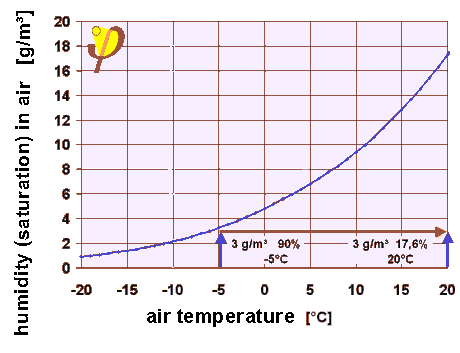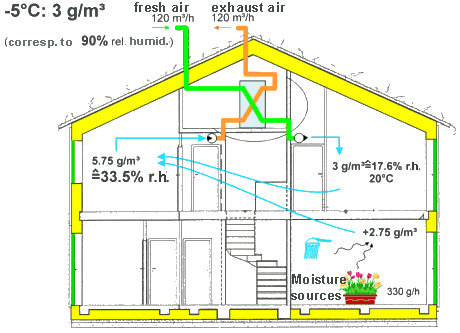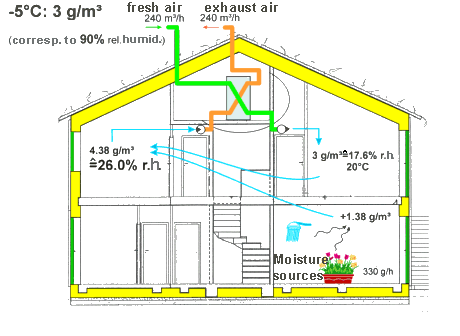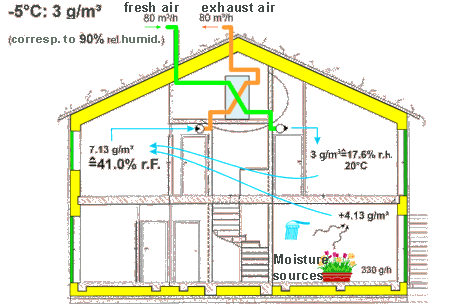| |
Ventilation and Humidity – |
|
|
The larger the volume of fresh air brought in from the outside, the lower the relative humidity in the house.
If one wants to keep
the humidity higher in the winter time, the simplest way is
to reduce the fresh air quantities, which reduces the dilution
of humidity in the room air. An outside air quantity of 80 m³/h
(based on to 20 m³/h for each person) is still enough for acceptable
interior air quality according to experience (see measurements
in different Passive Houses). With this outside air quantity,
the relative humidity in the house becomes 41%. (the air change
rate is about 0.25 h-1 based on the whole house volume.
|
| The amount of the relative humidity in the interior air of a building depends on the following critical variables:
The water vapour generated by the internal sources is diluted by the supply of fresh air. It doesn't matter whether outside air is brought in through cracks, windows or by a ventilation system. Nor does it matter if air is warmed up (e.g. by a heat recovery) - the amount of water contained in the air flow is unchanged by these processes. This dilution effect is particularly strong in the winter; cold outside air contains very little water vapor (with -5°C/90% e.g. only about 3 g per cubic meter of air, see first diagram at left). If this air is brought inside, it is eventually warmed up to 20 °C and then its relative humidity amounts to only 17.6% - as long as no additional water from internal sources of is supplied to the room air. In the case of typical household moisture sources (330 g/h - varies individually) and a "standard" ventilation air volume (in the example 120 m³/h - as per DIN 1946), then the result is a relative interior air humidity of 33.5%. This level of humidity is usually comfortable if the air is fairly clean. If during standard ventilation the air humidity appears too low to the inhabitants, there is an easy remedy: By decreasing the outside air flow rates, the relative interior air humidity rises, because the sources of water vapour are diluted less. So the occupants may just reduce the outside air quantity in the above wintertime example to on 80 m³/h - which is still permissible for sufficiently good indoor air quality - as a result, the relative humidity of the indoor air rises to approximately 41%. Nobody should supply more fresh air than is necessary for good indoor air qualty, because it affects the comfort of the occupants by changing the humidity. Conventional ventilation planners are inclined to specify rather high ventilation amounts for dwellings. There were times when 0.5-ach (or even 0,8-ach) was specified, precisely to keep the indoor humidity levels low during the winter in order to reduce the risk of condensation and mold. These two dangers do not exist in the Passive House, because of the good thermal protection for all external construction components interior surfaces are so warm that even with 60% room air humidity, there is still no condensation. Therefore the fresh air quantity can be reduced somewhat in the passive house during the winter, in particular if the room air humidity is felt by the inhabitants to be too low. "reference values" for dwellings are house air changes performed by the ventilation system of between 0.3 and 0.4-ach. For Passive Houses we generally give the recommendation to specify the amount of air to the lower of the two values. Then the room air humidity remains comfortable, along with good air quality. Remedies for indoor humidity levels:
By the way: Practically dust free air even with low moisture level is not felt to be "too dry"; in the cold mountain air we feel fine. However, air in dwellings, given reasonable actions, cannot be kept dust free . Therefore there exists a lower boundary for relative humidity (with approx.. 30%). Below this, most people find the air to be too dry, so refer to points 1. and 2. as described above to solve the problem. If maintaining comfortable levels of indoor humidity will require reducing ventilation air volumes below those necessary for good indoor air qualty, then a mechanical humidifier can be used instead, but this must be cleaned and refilled regularly. At the Passive house conference in working group II, Ruedi Krisi presented Enthalpy recovery ventilators, which recover humidity in addion to heat. Also at the current passive house conference new results of the ventilation research are expected. This link leads to the main site of the Introduction to Passive Houses. (last
changed: 6.05.2007 / author Dr. Wolfgang Feist; thanks
to David Stecher for proof reading of the 1st edition |



